The cockroach is an oval-shaped insect that infests residential areas, buildings, restaurants, and warehouses. They have impressive adaptability and are capable of surviving harsh environmental conditions. The infestation of cockroaches can pose serious health risks and lead to microbial diseases. There are around 4,600 identified species of cockroaches, and most of them have similar traits and external features.
What does a cockroach look like? A cockroach is an oval-shaped insect that belongs to the order of insects called Blattodea. It has a reddish to dark brown colored tri-segmented body, six legs, two antennae, large compound eyes, and two pairs of flat wings. Cockroaches are quite big insects and can grow up to three inches.
The three main developmental stages of cockroaches are egg, nymph, and adult stage. Nymph is a wingless baby cockroach that looks like an adult roach.
Accurate identification and prevention is the key to dealing with the infestation of cockroaches. That is why in this article, we have provided a comprehensive identification guide and necessary details about different types of cockroaches. Let’s begin!
External Characteristics of Cockroaches | Information
Cockroaches are found all over the world except Antarctica, about 70 species of cockroaches have been identified in the United States and only a few of them are common household pests. Although most of the cockroach species have some similarities, they can be differentiated based on their distinctive behavior and biological characteristics. Cockroaches have three major developmental stages: egg, nymph, and adult.
Each species lays eggs in capsules (known as ootheca) that have different characteristics and the number of eggs varies from species to species which also helps to identify them. The color of an adult cockroach (yellowish or reddish-brown to dark brown) and size (0.25 inch to 3 inches) also differs depending on the type of cockroach.
How to Identify a Cockroach?
All cockroaches have a flat, oval-shaped body, six spiny legs, a pair of antennae, large compound eyes, cerci appendages, and 2 flattened pairs of wings (vestigial wings in some cases) that may or may not help with flying. Even though some cockroach species have fully developed wings, they still prefer crawling instead of gliding or flying. The cockroaches tend to fly or jump for self-protection, mating, or to overcome harsh environmental conditions.
The specialized pads on their legs help them crawl on the ceilings and on other surface areas. Their body appears reddish-brown to black in color. However, it can be whitish temporarily, as they can change color during the molting phase (shedding of the exoskeleton).
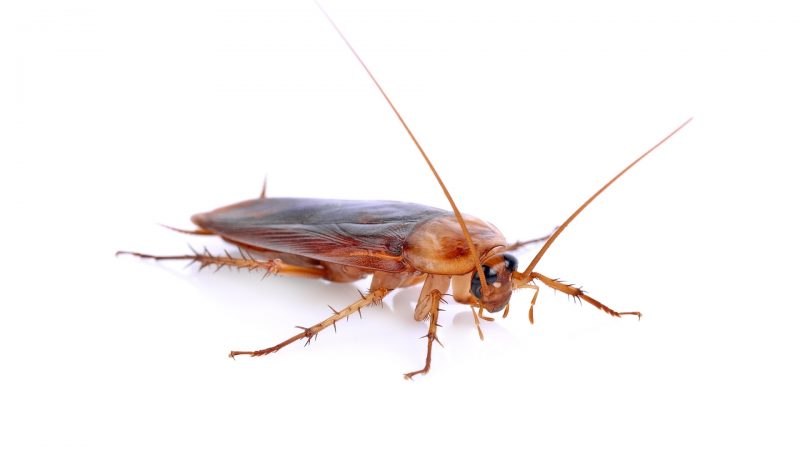
The body of a cockroach has a thorax with 3 segments and its abdomen is further divided into 10 segments. Some cockroaches have bands or parallel lines on their back. The weight of the heaviest cockroach has been recorded as around 30 grams. We can identify cockroach species by their external distinct characteristics, body size, and color. The cockroaches can also be differentiated by their different sizes at developmental stages.
As mentioned before, cockroaches can survive in a varying range of temperatures but they prefer to live in warm and moist conditions such as basements, bathrooms, kitchen sinks, warehouses, drains, pantries, kitchen cabinets, or cupboards.
What Do Baby Cockroaches Look Like?
Baby cockroaches are also named nymphs. Nymphs are hatched from eggs after an incubation period of two to three months (this number varies from species to species). They look like adult cockroaches but have small, pale and wingless bodies. They range between 2 mm to 5 mm and their whitish body turns darker after a few hours of hatching.
A young nymph develops into a mature adult by repeated shedding of the exoskeleton or cuticle. The development process may take more than a year depending on the species of cockroach.
American cockroach measures up to 1/4 inch long at the nymph stage. After molting, their blackish-brown body changes to reddish-brown. On the other hand, German cockroach nymphs have around 1/8 inch long bodies and a dark brown appearance. They develop into a pale brown adult as they grow.
The oriental cockroach has a reddish-brown appearance and measures up to 1/4 inch long at the nymph stage. However, adult oriental cockroaches have black bodies and grow up to 1 1/4 inches long.
What Do Cockroach Eggs Look Like?
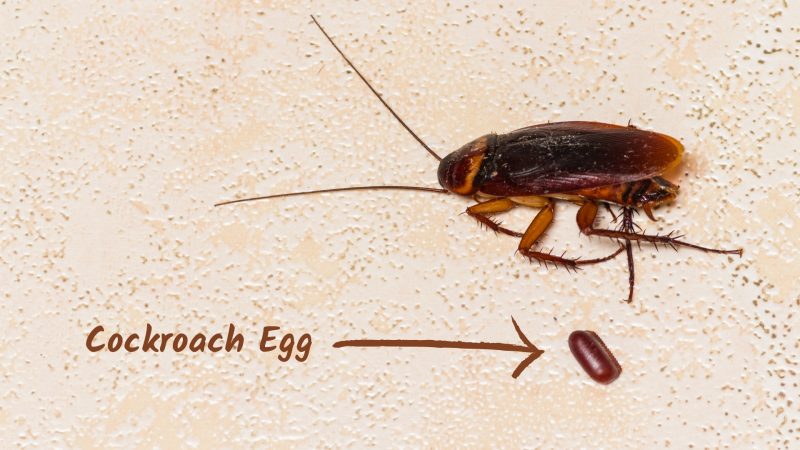
Female cockroaches lay eggs in groups. Ootheca remains attached to the female body for one or two days or for several weeks in the case of the German cockroach.
The different female cockroach species can produce about 4 to 30 egg casings in their lifetime and each ootheca may comprise from 16 to 50 eggs depending upon the type of cockroach. The eggs of cockroaches are small, capsule-shaped, and tan, brown, or black in color. They range between 5 mm to 12 mm in length.
The distinctive characteristics of oothecae also help to determine the species of cockroach. The eggs hatch within 1 to 3 months depending upon the environmental conditions and cockroach species.
What Do Cockroach Larvae Look Like?
In cockroaches, nymphs are hatched from eggs instead of going through the larval stage. The nymph of the cockroach looks like an adult cockroach. However, it is smaller in size and has a different body color. During the molting phase, the nymph develops into an adult after repeated shedding of the exoskeleton and a series of changes.
What Does a Queen Cockroach Look Like?
Cockroaches (solitary insects) are not categorized with social insects such as honey bees or ants. They do not have a caste system or a queen but they do have a female cockroach that produces eggs.
Female cockroaches are usually bigger in size and darker in color than their counterparts. You will easily be able to identify them.
What Does a Cockroach Nest Look Like?
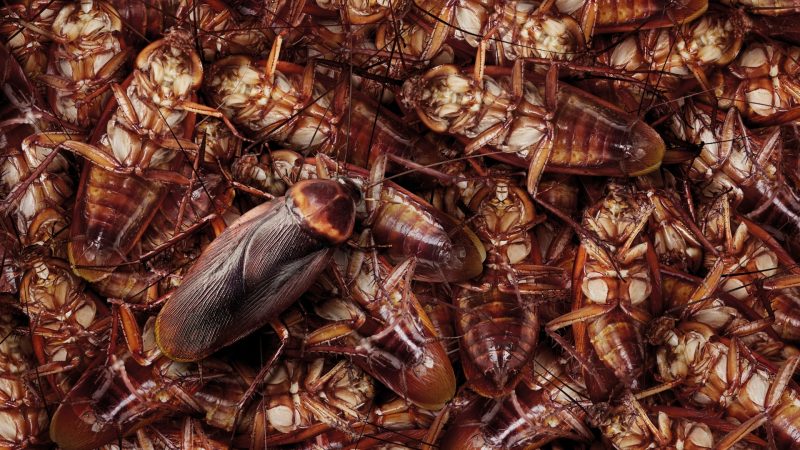
Cockroach nests can be anywhere, in cupboards, under the sink, in kitchen cabinets, behind furniture, in wall voids, or at other warm, compact, and dark places. You can find the nesting sites of cockroaches by locating their egg cases, dead skin, droppings, or dark spots. The cockroaches release a substance that attracts other cockroaches to their hideouts.
What Does Cockroach Poop Look Like?
Like the other distinct traits, the fecal matter of cockroaches also differs in appearance from species to species. Their poop is brown to black in color and it looks like a coffee ground or black pepper. Depending on the species they can excrete small round droppings while others produce cylindrical and ridged feces.
For instance, poop or droppings of German cockroaches look like coffee grounds. The American cockroach droppings look like a fecal matter of a mouse but it is smaller in size, with a blunt and ridged appearance.
However, oriental cockroach excretes droppings that are tapered at one end and round at the other. The fecal matter of cockroaches contains airborne allergens that can induce the symptoms of asthma in asthma patients.
What Does a Cockroach Bite Look Like?
Cockroaches are not aggressive in nature and do not bite like some other insects. However, there are some reports of people getting cockroach bites on their fingernails, hands, and feet. They will only bite when there is a massive infestation and when they have no other food source.
The cockroach bite looks similar to a bed bug bite. The infected area may have a swelling or bright red spot that is around one to four mm in size. In severe cases, the infected area may cause lesions or minor wounds.
What Do Small Cockroaches Look Like?
Cockroaches can be as small as the size of a penny. There are thousands of identified species of cockroaches. Among them, the most prevalent smallest cockroach species are brown-banded cockroaches and German cockroaches, measuring around 1/2 inch long.
The brown-banded cockroaches are brown in color with bands around their wings whereas German cockroaches have a light brown appearance with parallel stripes on their back.
What Does a Large Cockroach Look Like?
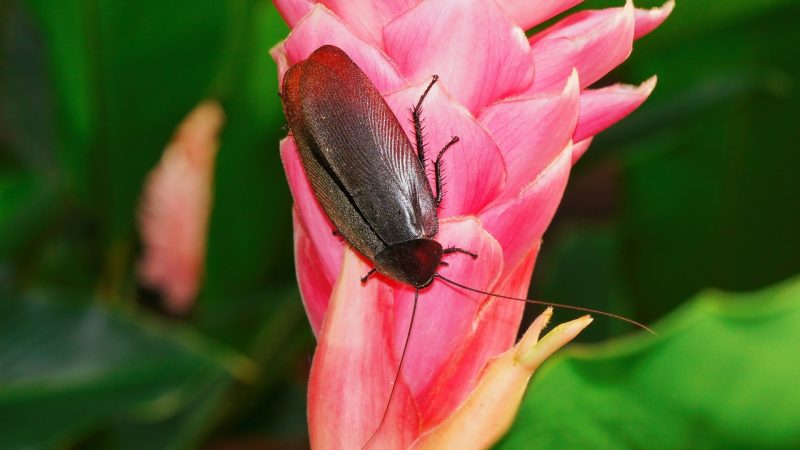
The largest species of cockroach (Megaloblatta longipennis) can grow up to 3.8 inches and have a long wingspan of about 7.9 inches. This particular species has a reddish-brown appearance. American cockroach are also considered to be one of the biggest cockroach species. It has a reddish-brown body that ranges between 1.5 to 3 inches in length.
Specific Types of Cockroaches and How They Look Like
Cockroaches are one of the most notorious pests due to their impressive adaptability and the potential to infest in your houses and buildings. According to studies, they can carry 33 different types of bacteria, 6 types of parasitic worms and 7 different pathogens, making them extremely dangerous.
Before dealing with a cockroach infestation, you should have an idea about the appearance of some of the most common cockroach species. Further, we have given specific types of cockroaches and their external features.
What Does a German Cockroach Look Like?
German cockroach (Blattella germanica) has a light brown to the tan colored body and is able to grow up to 1/2 inch long (between 12 to 15 mm). These cockroaches are notorious for their worldwide presence. We can differentiate the German cockroaches from other species by two dark markings on their back (at pronotum).
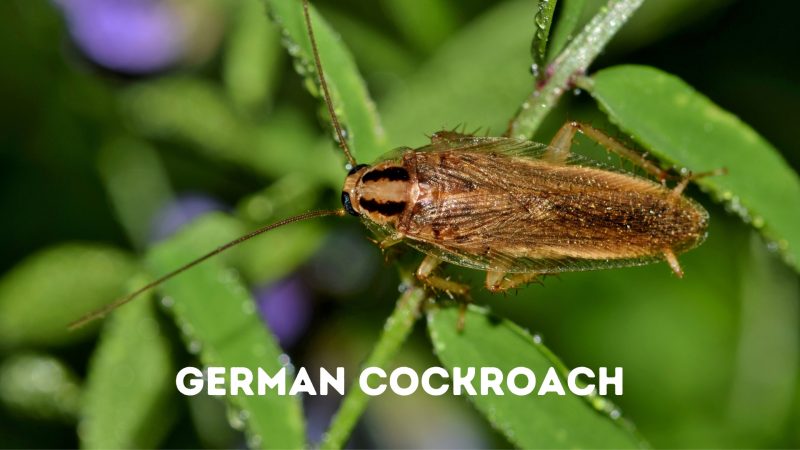
Males of the German cockroaches have tapered abdomens and are thinner and more slender in comparison to their females. They have vestigial wings, therefore, are not able to fly.
The females deposit 35 to 40 eggs. The eggs hatch in one month and the nymphs develop into adults in 6 weeks to 6 months. This is the most common indoor pest and prefers to live in humid surroundings such as bathrooms, kitchens, drains, and other moist places.
What Does an American Cockroach Look Like?
The American cockroach (Periplaneta americana) is one of the most prevalent species of cockroach in the United States. They have a reddish-brown body that ranges between 1.5 to 3 inches in length. These cockroaches are fast runners and have well-developed wings that help them glide. Wings in male American cockroaches are longer than their body whereas in females wings are shorter.
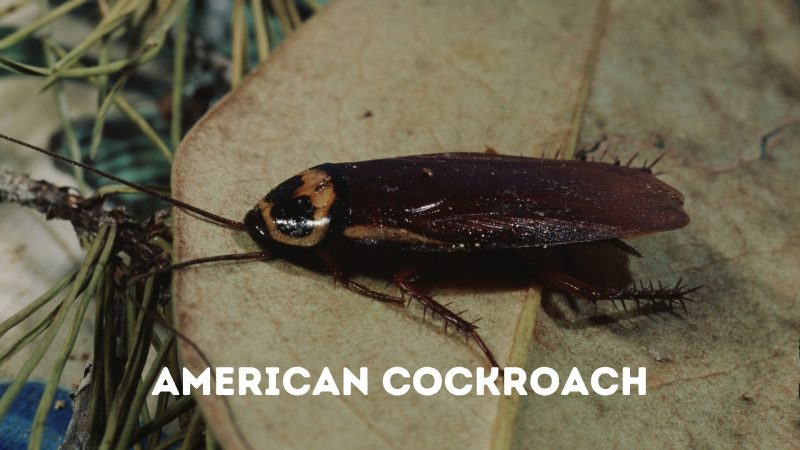
The female is able to have around 16 eggs in each ootheca and carries them for several days. The ootheca is dark brown in color and measures around 8 mm. The female cockroach can produce about 10 to 30 egg capsules in its lifetime. The nymph emerges in 1 to 2 months but the development period can vary between 6 months to 12 months or more depending upon environmental conditions. The American cockroaches are often confused with “Palmetto bugs”.
What Does a Hissing Cockroach Look Like?
Madagascar hissing cockroach (Gromphadorhina portentosa) is a wingless species of cockroach from the island of Madagascar. These cockroaches are shiny brown in color and have a body that is around 3 inches long (one of the largest species).
Males have a peculiarly large pronotal hump or horns on their thorax and bushier antennae in comparison to females. Their padded feet allow them to climb on almost any type of surface.
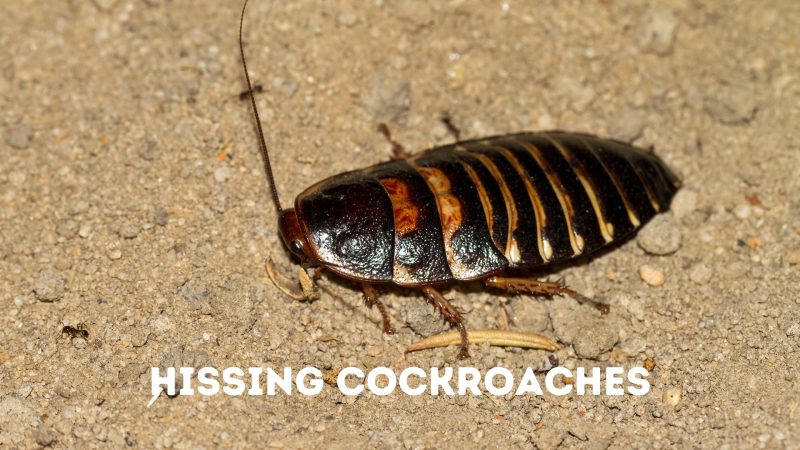
Males of hissing cockroaches are aggressive in nature and fight with their rivals using horns. During the fight, hissing sounds are produced, and that is why they were named “Hissing cockroaches.” Cockroaches that are winning produce more hisses than the losing ones. The sound also helps to attract females.
What Does an Oriental Cockroach Look Like?
The oriental cockroaches (Blatta orientalis) have a dark brown to black body with a greasy shine and they are able to grow up to 1.5 inches (approximately). Wings in the males cover 3/4th of their abdomen whereas females have underdeveloped wing pads with a broader and heavier appearance.
A female Oriental cockroach can lay around 16 eggs which are hatched in about 2 months, while the rest of the development phase is around 6 to 18 months. They prefer to live near warm and moist indoor and outdoor areas such as under sinks, washing machines, refrigerators, or near leaky pipes and drains, etc.
Common Bugs That Look Like Cockroaches
There are a number of insects that are mistaken for cockroaches due to their similar size or external appearance. In the following section, we have provided a list of common bugs that look like cockroaches.
A Complete List of Bugs That Look Like Cockroaches
The common bugs that resemble cockroaches are:
- Wood-boring beetles
- Asian Long-horned beetles
- Palo Verde beetles
- Ground beetles
- Water bugs
- Bed bugs
- Termites
- Crickets
- Leaf-footed bugs
- June bugs
Water Bug That Looks Like a Cockroach
Many people confuse water bugs with cockroaches due to their similar color and body. The water bugs have oval-shaped and brownish bodies like cockroaches. The distinguishing features between water bugs and cockroaches are their legs and body size.
Water bugs have two pairs of legs whereas cockroaches have three pairs of spiny legs. Water bugs can grow up to 4 inches and are easily drawn to light, unlike cockroaches. Additionally, water bugs do not have feelers (antennae) like cockroaches, and they are blood-feeding insects that live near ponds or other water reserves.
Beetles That Look Like Cockroaches
June Beetle
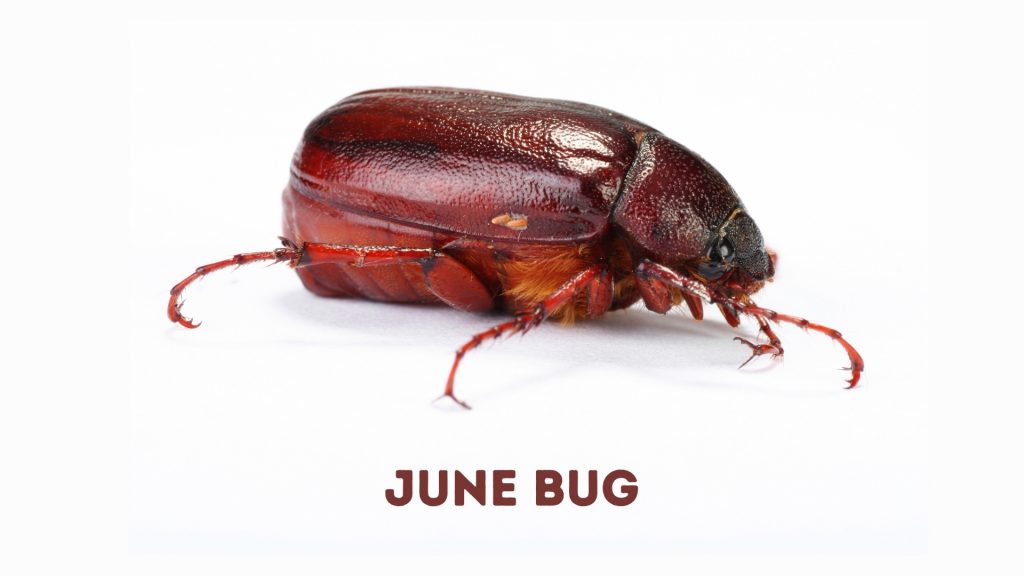
June beetle is referred to as June bug or May beetle. This beetle has a reddish-brown to blackish body and feelers similar to cockroaches. June beetles are around an inch longer. They are active at dusk during May, and earlier in June, and are attracted to light, unlike roaches.
The distinctive features of June beetles are their higher rounded backs and stockier appearance when compared to cockroaches.
Ground Beetle
Ground beetles and cockroaches look similar in their shape and body color. They have a brown or black flattened shiny body, long legs, and antennae that are similar to those of a cockroach.
Woodboring Beetle
Like cockroaches, wood-boring beetle has long antennae, six legs, translucent reddish-brown wings, and a cylindrical body. Wood boring beetle is smaller in comparison to cockroaches. These beetles bore into wood, therefore, if you notice a pest coming out of a wooden hole then you might be dealing with woodboring beetles.
Palo Verde Beetle
Palo verde beetles look like cockroaches due to their long body, color, size, and pair of antennae. However, unlike cockroaches, they can fly and have a harder shell.
Asian Long-Horned Beetle
Asian long-horned beetle can sometimes be confused with roaches in spite of their clear distinctive features. They have a black body with prominent white spots and long curled antennae.
Bugs That Look Like Baby Cockroaches
Crickets
Crickets have light yellow to the brown bodies, and hard shells and are less than an inch long. Like some cockroach species, the wings of crickets cover up their abdomen. They produce chirping sounds by rubbing their wings together.
The characteristics that differentiate them from cockroaches are three transverse bands on the head and the shape of their legs. Their hind legs allow them to jump higher and faster.
Leaf Footed Bug
Leaf-footed bugs have size, body color, and wings similar to flying cockroaches. They have brown bodies and are around an inch long. Unlike cockroaches, they have white bands on the edges of their wings.
Bed Bugs
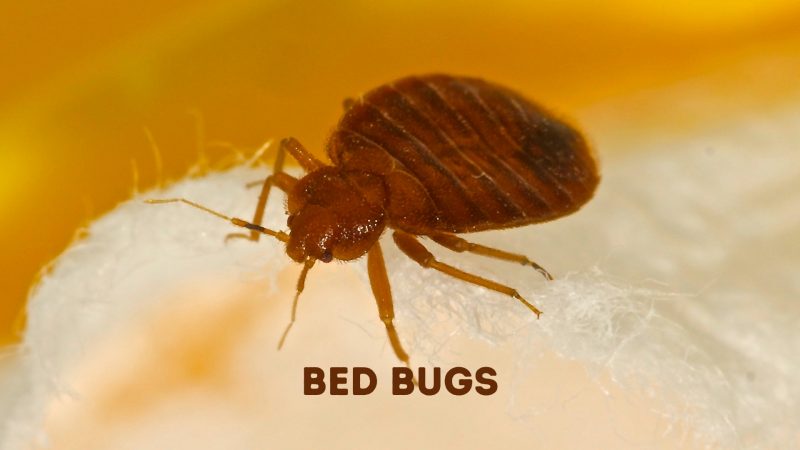
Bed bugs have a flattened, oval-shaped, reddish-brown body like cockroaches. The cockroaches have wings and many of them can glide. On the other hand, bed bugs do not fly and they feed on human blood. Beg bugs are much smaller in size when compared to cockroaches.
List of Sources
Hahn, J. and Ascerno, M. (2018). Cockroaches. Extension entomologist, University of Minnesota
Peairs, F. B. (2012). Cockroaches. Colorado State University Extension entomologist, Biological and Agricultural Pest Management
Bennett, G. W. (2017). Household and Structural Cockroaches. Purdue University Extension
Brown, W., Merchant, M. and Siders, K. (2017). Cockroach Biology and Management. Texas A & M Agrilife Extension
- Bed Bug Surge 2025: How to Detect, Prevent, and Safely Eliminate Infestations in Top U.S. Cities - June 18, 2025
- Asian Needle Ants Invade US Homes: 2025 Guide to Identification, Risks, and Effective Control - June 11, 2025
- New World Screwworm Alert: How US Livestock Owners Can Prevent Outbreaks and Protect Herds [Summer 2025 Update] - June 8, 2025
